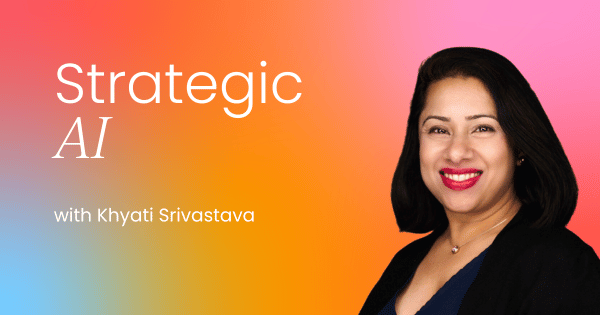Right now, it feels like all anyone talks about is generative AI. You log into LinkedIn, scroll Twitter, and overhear conversations on the bus like, “It’s AI-enabled, so it must be amazing.” But is it really?
There are basically two ways to think about AI today. First, there’s the overwhelm – the pressure to keep up or risk falling behind because AI is everywhere. Then, there’s fascination – the exciting potential of what AI can do. I’m here to help you navigate that tension.
We’ll cover why AI is better thought of as an enabler and multiplier – helping you research smarter, create faster, and strategize more effectively. I’ll share practical frameworks, real-world examples, and tips on working with AI prompts so you don’t just keep up, but get ahead.
Whether you’re overwhelmed or fascinated, this article will give you the clarity you need to make AI work for you.
The generative AI explosion: A game changer with a confusing narrative
Before we dive in, let’s remember that AI isn’t new. It’s been around for years, quietly woven into our daily lives. From fraud detection (my background) to speech recognition, and even Netflix recommending your next favorite show – that’s all AI. It’s so integrated we barely notice it anymore.
What’s really exploded onto the scene over the last couple of years is generative AI – AI literally at your fingertips. Text, images, video, prompt-driven tools, and connections to large language models (LLMs).
But the story around generative AI has been confusing. “AI will take your job.” “There are too many risks.” “Learn it or get left behind.” It’s a mix of hype and fear, and honestly, an overpromise in some ways.
This article is based on Khyati Srivastava’s presentation at the AI for Marketers Summit, which is returning to San Francisco on September 11, 2025.
Grab your ticket here.
Content generation isn’t the whole story
Every new technology has a starting point. For AI, it’s often content creation – logging into ChatGPT and asking it to write for you.
However, just using AI to generate content comes with risks. For example, if someone on your team isn’t familiar with your industry and relies solely on AI-generated content, the output might lack accuracy, specificity, and uniqueness. AI can’t replace real user knowledge – it can only fill gaps, sometimes poorly.
Plagiarism is another concern. ChatGPT doesn’t always make it clear where its info comes from, which is why tools like Perplexity AI are gaining traction. Even with prompts, it’s tricky to get solid sources, so accidental plagiarism happens.
Have you noticed ChatGPT’s content tends to be generic? It pulls from tons of places but rarely includes your company’s unique user stories or case studies.
And when it comes to SEO – well, it’s evolving into GEO (generative engine optimization). Success now depends on having sources, stats, quotes, and tailoring that make your content truly unique and engaging.
Beyond content generation: Generative AI as an enabler, a multiplier, and a natural evolution
If you think AI – and ChatGPT in particular – is just about content generation, I’m here to tell you it’s much more than that. I see it as an enabler, a multiplier, and a natural evolution of how we work.
Think about it: we didn’t jump from the abacus straight to Excel. We moved through calculators, then computers – each step a natural evolution that made our lives easier. Similarly, why should you still go to Google, sift through countless search results, and do a bunch of manual filtering just to find what you need?
Why not let AI enable and multiply your work, evolving how you do things?
Gen AI for market research
A clear use case of generative AI is market research, but it’s just one of many.
Research usually goes through four stages: accelerating industry and trend research, identifying relevant segments and personas, promoting education and engagement, and finally extending and expanding that knowledge.
Here’s how generative AI acts as a multiplier and enabler at every step:



 Follow us on LinkedIn
Follow us on LinkedIn


